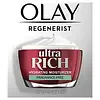What's inside
What's inside
 Key Ingredients
Key Ingredients

 Benefits
Benefits

 Concerns
Concerns

 Ingredients Side-by-side
Ingredients Side-by-side

Water
Skin ConditioningGlycerin
HumectantC13-15 Alkane
SolventPhenyl Trimethicone
Skin ConditioningSodium Acrylates Copolymer
Propanediol
SolventHydrolyzed Soy Protein
HumectantSodium Hyaluronate
HumectantAllantoin
Skin ConditioningAlpha-Glucan Oligosaccharide
CleansingArginine
MaskingAscorbic Acid
AntioxidantAscorbyl Palmitate
AntioxidantBisabolol
MaskingButylene Glycol
HumectantCaprylic/Capric Triglyceride
MaskingCaprylyl Glycol
EmollientChondrus Crispus Powder
AbrasiveCitric Acid
BufferingDiethylhexyl Syringylidenemalonate
Skin ProtectingDisodium EDTA
Ethylhexylglycerin
Skin ConditioningFructose
HumectantGlucose
HumectantGlyceryl Laurate
EmollientGlyceryl Oleate Citrate
EmulsifyingHydrolyzed Wheat Protein
Skin ConditioningLecithin
EmollientMaltose
MaskingPanthenol
Skin ConditioningParfum
MaskingPectin
Emulsion StabilisingPEG-8
HumectantPentylene Glycol
Skin ConditioningProline
Skin ConditioningPyrus Cydonia Fruit Extract
Skin ConditioningSerine
MaskingSodium Chloride
MaskingSodium Hydroxide
BufferingSodium Lactate
BufferingSodium PCA
HumectantSodium Polyacryloyldimethyl Taurate
Emulsion StabilisingTapioca Starch
Tocopherol
AntioxidantTocopheryl Acetate
AntioxidantTrehalose
HumectantUrea
BufferingXanthan Gum
EmulsifyingPhenoxyethanol
PreservativeWater, Glycerin, C13-15 Alkane, Phenyl Trimethicone, Sodium Acrylates Copolymer, Propanediol, Hydrolyzed Soy Protein, Sodium Hyaluronate, Allantoin, Alpha-Glucan Oligosaccharide, Arginine, Ascorbic Acid, Ascorbyl Palmitate, Bisabolol, Butylene Glycol, Caprylic/Capric Triglyceride, Caprylyl Glycol, Chondrus Crispus Powder, Citric Acid, Diethylhexyl Syringylidenemalonate, Disodium EDTA, Ethylhexylglycerin, Fructose, Glucose, Glyceryl Laurate, Glyceryl Oleate Citrate, Hydrolyzed Wheat Protein, Lecithin, Maltose, Panthenol, Parfum, Pectin, PEG-8, Pentylene Glycol, Proline, Pyrus Cydonia Fruit Extract, Serine, Sodium Chloride, Sodium Hydroxide, Sodium Lactate, Sodium PCA, Sodium Polyacryloyldimethyl Taurate, Tapioca Starch, Tocopherol, Tocopheryl Acetate, Trehalose, Urea, Xanthan Gum, Phenoxyethanol
Water
Skin ConditioningNiacinamide
SmoothingGlycerin
HumectantHexyldecanol
EmollientDimethicone
EmollientParaffin
PerfumingStearyl Alcohol
EmollientPolyacrylamide
Panthenol
Skin ConditioningCetyl Alcohol
EmollientButyrospermum Parkii Butter
Skin ConditioningHydrogenated Polydecene
EmollientTocopheryl Acetate
AntioxidantPalmitoyl Pentapeptide-4
Skin ConditioningHydroxyacetophenone
AntioxidantLaureth-7
EmulsifyingCetearyl Alcohol
EmollientCetearyl Glucoside
EmulsifyingBehenyl Alcohol
EmollientArachidyl Alcohol
EmollientDisodium EDTA
PEG-100 Stearate
Polysilicone-11
C13-14 Alkane
SolventPhenoxyethanol
PreservativeBenzyl Alcohol
PerfumingWater, Niacinamide, Glycerin, Hexyldecanol, Dimethicone, Paraffin, Stearyl Alcohol, Polyacrylamide, Panthenol, Cetyl Alcohol, Butyrospermum Parkii Butter, Hydrogenated Polydecene, Tocopheryl Acetate, Palmitoyl Pentapeptide-4, Hydroxyacetophenone, Laureth-7, Cetearyl Alcohol, Cetearyl Glucoside, Behenyl Alcohol, Arachidyl Alcohol, Disodium EDTA, PEG-100 Stearate, Polysilicone-11, C13-14 Alkane, Phenoxyethanol, Benzyl Alcohol
Ingredients Explained
These ingredients are found in both products.
Ingredients higher up in an ingredient list are typically present in a larger amount.
Disodium EDTA plays a role in making products more stable by aiding other preservatives.
It is a chelating agent, meaning it neutralizes metal ions that may be found in a product.
Disodium EDTA is a salt of edetic acid and is found to be safe in cosmetic ingredients.
Learn more about Disodium EDTAGlycerin is already naturally found in your skin. It helps moisturize and protect your skin.
A study from 2016 found glycerin to be more effective as a humectant than AHAs and hyaluronic acid.
As a humectant, it helps the skin stay hydrated by pulling moisture to your skin. The low molecular weight of glycerin allows it to pull moisture into the deeper layers of your skin.
Hydrated skin improves your skin barrier; Your skin barrier helps protect against irritants and bacteria.
Glycerin has also been found to have antimicrobial and antiviral properties. Due to these properties, glycerin is often used in wound and burn treatments.
In cosmetics, glycerin is usually derived from plants such as soybean or palm. However, it can also be sourced from animals, such as tallow or animal fat.
This ingredient is organic, colorless, odorless, and non-toxic.
Glycerin is the name for this ingredient in American English. British English uses Glycerol/Glycerine.
Learn more about GlycerinPanthenol is a common ingredient that helps hydrate and soothe the skin. It is found naturally in our skin and hair.
There are two forms of panthenol: D and L.
D-panthenol is also known as dexpanthenol. Most cosmetics use dexpanthenol or a mixture of D and L-panthenol.
Panthenol is famous due to its ability to go deeper into the skin's layers. Using this ingredient has numerous pros (and no cons):
Like hyaluronic acid, panthenol is a humectant. Humectants are able to bind and hold large amounts of water to keep skin hydrated.
This ingredient works well for wound healing. It works by increasing tissue in the wound and helps close open wounds.
Once oxidized, panthenol converts to pantothenic acid. Panthothenic acid is found in all living cells.
This ingredient is also referred to as pro-vitamin B5.
Learn more about PanthenolPhenoxyethanol is a preservative that has germicide, antimicrobial, and aromatic properties. Studies show that phenoxyethanol can prevent microbial growth. By itself, it has a scent that is similar to that of a rose.
It's often used in formulations along with Caprylyl Glycol to preserve the shelf life of products.
Tocopheryl Acetate is AKA Vitamin E. It is an antioxidant and protects your skin from free radicals. Free radicals damage the skin by breaking down collagen.
One study found using Tocopheryl Acetate with Vitamin C decreased the number of sunburned cells.
Tocopheryl Acetate is commonly found in both skincare and dietary supplements.
Learn more about Tocopheryl AcetateWater. It's the most common cosmetic ingredient of all. You'll usually see it at the top of ingredient lists, meaning that it makes up the largest part of the product.
So why is it so popular? Water most often acts as a solvent - this means that it helps dissolve other ingredients into the formulation.
You'll also recognize water as that liquid we all need to stay alive. If you see this, drink a glass of water. Stay hydrated!
Learn more about Water